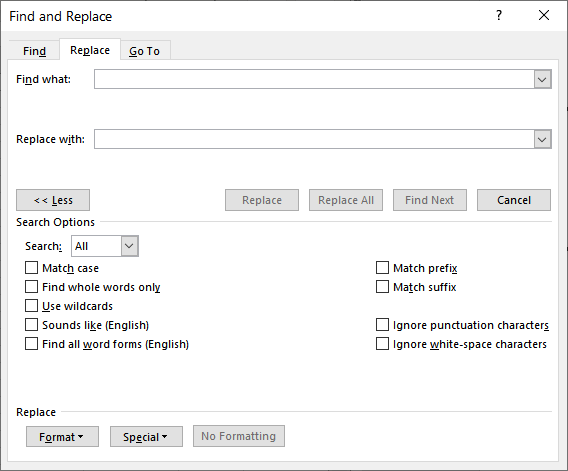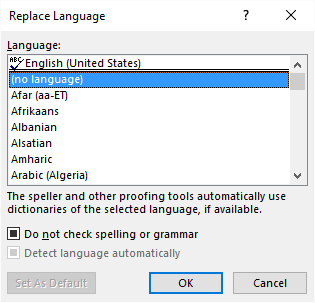Please Note: This article is written for users of the following Microsoft Word versions: 2007, 2010, 2013, 2016, 2019, and 2021. If you are using an earlier version (Word 2003 or earlier), this tip may not work for you. For a version of this tip written specifically for earlier versions of Word, click here: Ignoring the Spelling of Proper Nouns.
Written by Allen Wyatt (last updated October 24, 2020)
This tip applies to Word 2007, 2010, 2013, 2016, 2019, and 2021
David wants Word to ignore the spelling of proper nouns when doing a spell check. It seems that his documents contain many, many proper nouns (first letter of the noun is capitalized), and he is tired of "ignoring" them during a spell check.
There are two primary ways you can approach this problem. The first is to make sure that all the proper nouns you are likely to run into are in your custom dictionary. If you like, you can search for custom dictionaries already available on the Web.
If you have a little free time, however, a better approach might be to create the custom dictionary yourself. For instance, open five or ten representative documents and compile a list of all the proper nouns in those documents. This may be a huge list, but it shouldn't be too hard to create. I would use the following general steps to create the list, remembering to always work on document copies, not on the original documents:
At this point all the words that begin with capital letters are in one place in the document, as are all the words beginning with lowercase letters. Delete the words that begin with lowercase letters and remove any duplicates from those that begin with uppercase letters. The resulting list can then be added to your custom dictionary, as described in other issues of WordTips.
The second primary approach to the problem is to format your proper nouns for "no proofing." Words formatted in this manner are not included in the spell check or the grammar check. Formatting words in this manner can quickly get tedious, but there are helps. First of all, you could create a character style that has no proofing. This style could then be applied to your proper nouns, as desired. This approach is best used while you are initially editing the document. Second, you could create a macro shortcut to select the current word and apply the "no proofing" formatting. Again, this approach is great if you are initially writing the document.
If your documents are already written, it may be best to use a find-and-replace approach to formatting the proper nouns for no proofing. Before beginning, however, it is important to understand that Word cannot differentiate a proper noun at the beginning of a sentence from a non-proper noun; both use an initial capital letter. This means that you cannot create a pattern in Find and Replace that will differentiate between proper nouns at the beginning of a sentence and any other capitalized word at the beginning of a sentence.
With this in mind, you must figure out if you want to spell check the first word of each sentence or not. Logic would dictate that you do spell check first words in sentences, as there are likely fewer sentences that begin with proper nouns than sentences that don't.
Taking these caveats into consideration, you can follow these steps to use Find and Replace to format all proper nouns (except those at the beginning of sentences) as "no proofing."

Figure 1. The Replace tab of the Find and Replace dialog box.
[!.\?;:"\!] <[A-Z][A-z]@>

Figure 2. The Replace Language dialog box.
For some readers not familiar with pattern matching in Word, the Find What pattern (step 4) might be a bit intimidating. The first set of brackets defines a character that should be matched. Because the first character inside the brackets is an exclamation point, then Word will find any character except those listed. In other words, any character except a punctuation mark (period, question mark, semicolon, colon, quote mark, or exclamation mark) will be found by Word. (Notice that the question mark and exclamation marks are preceded by \ characters. This is because the question mark and exclamation marks normally have special meanings in pattern matching, and the slash tells Word to ignore that special meaning in this one case.)
If you use smart quotes in your document, you should also place a beginning smart quote in the first expression by pressing Alt+0147 (on the numeric keypad) within the brackets—perhaps right after the quote mark that is already there. In addition, if your word has a lot of abbreviations that use periods, such as Mr., Ms., or Dr., then you may want to delete the period from within the brackets.
The next character in the pattern is a space. With this in place, Word will search for a character that is not a punctuation mark and is followed by a space. Next, Word will find any capital letter—designated by the range [A-Z]—that begins a word. (The < sign indicates that the capital letter has to start at the beginning of a word.) This initial capital letter can be followed by any number (@) of other letters ([A-z]), uppercase or lowercase, at the end of a word (>).
When all this is put together, Word is searching for a word of at least two letters that starts with a capital letter and is not preceded by punctuation and a space. This means we are skipping all words that begin sentences. We are replacing them with the "no proofing" format so that Word will not spell check them.
Astute readers familiar with pattern matching will note that the search expression selects not only the capitalized word, but also the last letter of the preceding word before replacing the expression with "no proofing". However, since the rest of the preceding word is not marked as "no proofing", it will still be spell checked.
For example, suppose you have the following trite sentence:
The man named Wyatt writes a newsletter.
The search pattern would match the characters "d Wyatt" and mark them for "no proofing." Nevertheless, Word will find a spelling mistake if you had actually written the following
The man namd Wyatt writes a newsletter.
Word will still catch "namd" as being spelled incorrectly, even though the "d" is marked for "no proofing."
WordTips is your source for cost-effective Microsoft Word training. (Microsoft Word is the most popular word processing software in the world.) This tip (9890) applies to Microsoft Word 2007, 2010, 2013, 2016, 2019, and 2021. You can find a version of this tip for the older menu interface of Word here: Ignoring the Spelling of Proper Nouns.

The First and Last Word on Word! Bestselling For Dummies author Dan Gookin puts his usual fun and friendly candor back to work to show you how to navigate Word 2019. Spend more time working and less time trying to figure it all out! Check out Word 2019 For Dummies today!
Want to add words easily to the spelling exclusion list? Here's a macro that can make the task completely painless.
Discover MoreDon't like it when Word always says a word is spelled right and you know that it isn't? Here's how you can fine-tune the ...
Discover MoreThe spell-checking tool built into Word allows you to easily add words to a custom dictionary. What happens, though, if ...
Discover MoreFREE SERVICE: Get tips like this every week in WordTips, a free productivity newsletter. Enter your address and click "Subscribe."
2025-06-28 10:58:02
Barbie
First, adding proper names to the Custom Dictionary seems "safer" than setting them to "no proofing," as they will then be flagged if they are indeed spelled incorrectly. (I've given characters names and then forgotten how I originally spelled them...)
That being said, I don't see why it is necessary to go through the steps of creating a list to add to the Custom Dictionary all at once. The first time the spell checker encounters each name, double check that you have typed it correctly, and then click "add to dictionary" instead of Ignore.
2020-10-25 04:11:44
Ken Endacott
The word count list given by the app https://design215.com/toolbox/wordlist.php is a very useful way of checking for consistent spelling of proper nouns and consistency where the spell checker accepts alternative spellings of a word.
The results of the app are in alphabetic order and by scanning down the list it is easy to identify two words that have a slightly different spelling.
2020-10-24 13:05:36
Karen Schouest
Hi, Allen -
QUESTION: I encounter this issue all the time in my work with lengthy dissertations and court transcripts. Thanks for sharing this great tip. DUH, why didn't I think of that! :) Meanwhile, I have a question and an additional tip to add.
Have you ever seen where Word will just ignore the case sensitive option in sort? Mine just flat-out won't do it. I have Microsoft 365, Word version 2009 (Build 13231.20418). I first tried it with a mega-document with 25,000-plus words. Then I decided to try a small test document, using a new blank document with only 10 words. Neither worked. I'm stumped. Any thoughts?
TIP: You can save several steps your above-described process by copying the text of the document into a list maker app, such as this one:
https://design215.com/toolbox/wordlist.php
This instantaneous process of copying-and-pasting the text into the app and processing it will automatically remove all punctuation iterations -- commas, periods, question marks, exclamation marks, single and double quotation marks, parentheses, square brackets, curly brackets, tabs, etc., and produce a list of only unique words. Easy-peasy! There are several similar apps to be found on Google, each with a different feature or two, and some of them include a one-time purchase or subscription fee. The link above is free. Using a third-party app also eliminates the frustration that Word sometimes will balk and say that the text is too large to process.
With the above-linked app, you'll want to be sure that the following boxes are checked: (1) remove duplicate words, (2) preserve case, (3) do not separate hyphenated words, and the following boxes are unchecked: (1) show word frequency, (2) only show totals > 1.
O course, even though it produces a sorted list, the initial-capped words are interspersed with the lowercase words, so you'll still have to sort it again in Word to isolate the initial-capped words.
Now, if I can only get my Word sort to work correctly with the case-sensitive option, I can take advantage of your gem of a tip, Allen!
Thanks in advance!
~Karen :)
Got a version of Word that uses the ribbon interface (Word 2007 or later)? This site is for you! If you use an earlier version of Word, visit our WordTips site focusing on the menu interface.
Visit the WordTips channel on YouTube
FREE SERVICE: Get tips like this every week in WordTips, a free productivity newsletter. Enter your address and click "Subscribe."
Copyright © 2026 Sharon Parq Associates, Inc.
Comments